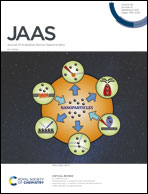Studying gold nanoparticle degradation during laser ablation–single particle-inductively coupled plasma mass spectrometry analysis†
Abstract
Nanoparticle (NP) analysis performed by laser ablation–single particle-inductively coupled plasma mass spectrometry (LA-sp-ICPMS) has recently allowed for multimodal insights to be gained about NPs in biological tissues. In our previous work, NP localizing, sizing and counting, as well as differentiating between the metal NP signal and its ionic form were achieved. In all of these, a low laser fluence (<1 J cm−2) was used, as it was observed that higher laser fluences can induce NP degradation, thus invalidating the results. This work is an in-depth study of gold NP (AuNP) degradation upon laser ablation, and provides guidelines for selection of the optimal laser fluence associated with NP analysis in gelatine as a matrix which mimics biological tissues. AuNPs of known size and with a narrow size distribution (CV < 5%) were used to keep track of the measured NP size with changing laser fluence. In addition, optical profilometry was utilized to measure the amount of material ablated as a function of the laser fluence, and provide a more accurate estimation of the NP degradation.



 Please wait while we load your content...
Please wait while we load your content...